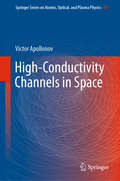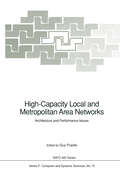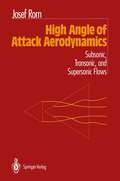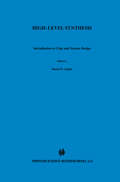- Table View
- List View
High-Conductivity Channels in Space (Springer Series on Atomic, Optical, and Plasma Physics #103)
by Victor ApollonovThis book discusses the physics of conductive channel development in space, air and vacuums and summarizes the attempts to create super-long conductive channels to study the upper atmosphere and to complete specific tasks related to energy transmission from the space to earth with high-voltage high repetition rate electrical sources. Conductive channels are produced by the laser jet engine vehicle-propulsion under the influence of powerful high repetition rate pulse-periodic laser radiation by CO2-laser, solid state Nd YAG,HF/DF laser systems generated with each pulse of the powerful laser conductive dust plasma. The book also presents the experimental and theoretical results of conductive canal modeling: the laser jet engine vehicle “Impulsar”, which can reach the lower layers of the ionosphere in several hundred seconds. Further, the book explores the development of lightning protection systems. The so-called long laser spark is generated to provide the conditions for connecting a thunderstorm cloud with a grounded metal rod, i.e. a classical lightning rod. Such conductivity channels can be used for energy transmission, overvoltage protection systems, transport of charged particle beams and plasma antennas. It provides the theoretical and experimental basis of high repetition rate P-P mode of operation for high power lasers (COIL, HF/DF, CO2,Nd YAG). It describes high efficiency and excellent beam quality disk lasers used for numerous applications, including surface treatment of dielectric materials in microelectronics, cutting, drilling, welding, polishing and cleaning of the surface and other technological operations. Lastly it investigates how megawatt mono-module disk lasers could be used to solve various problems: small satellites launched by lasers, formation of super-long conducting channels in space and atmosphere, cleaning of the near-earth space from the space debris and related applications.
High Concentrator Photovoltaics: Fundamentals, Engineering and Power Plants (Green Energy and Technology)
by Pedro Pérez-Higueras Eduardo F. FernándezThe aim of this book is to provide a comprehensive overview of the fundamentals and engineering of high concentrator photovoltaic (HCPV) technology and to elucidate how this complex and emerging technology is applied in power plants. It is the first of its kind to focus exclusively on HCPV technology and offers a valuable reference volume to readers. This book is the result of an international collaboration among experts and each chapter is written by a specialist in the field.The conversion of solar energy to electricity plays an important role in power generation and HCPV is signalled by many researchers and professionals as one of the most promising sources of solar power. Therefore this book provides an important resource for companies, research institutes and universities to assist with the understanding of fundamentals, different applications and potential of such technology.
High-Capacity Local and Metropolitan Area Networks: Architecture and Performance Issues (NATO ASI Subseries F: #72)
by Guy PujolleThe main objective of this workshop was to review and discuss the state of the art and the latest advances· in the area of 1-10 Gbit/s throughput for local and metropolitan area networks. The first generation of local area networks had throughputs in the range 1-20 Mbit/s. Well-known examples of this first generation networks are the Ethernet and the Token Ring. The second generation of networks allowed throughputs in the range 100-200 Mbit/s. Representatives of this generation are the FDDI double ring and the DQDB (IEEE 802.6) networks. The third generation networks will have throughputs in the range 1-10 Gbit/s. The rapid development and deployment of fiber optics worldwide, as well as the projected emergence of a market for broadband services, have given rise to the development of broadband ISDN standards. Currently, the Asynchronous Transfer Mode (ATM) appears to be a viable solution to broadband networks. The possibility of all-optical networks in the future is being examined. This would allow the tapping of approximately 50 terahertz or so available in the lightwave range of the frequency spectrum. It is envisaged that using such a high-speed network it will be feasible to distribute high-quality video to the home, to carry out rapid retrieval of radiological and other scientific images, and to enable multi-media conferencing between various parties.
High Calorie Diet and the Human Brain: Metabolic Consequences of Long-Term Consumption
by Akhlaq A. FarooquiThe purpose of this monograph is to present readers with a comprehensive and cutting edge description of neurochemical effects of diet (beneficial and harmful effects) in normal human brain and to discuss how present day diet promotes pathogenesis of stroke, AD, PD, and depression in a manner that is useful not only to students and teachers but also to researchers, dietitians, nutritionists and physicians. A diet in sufficient amount and appropriate macronutrients is essential for optimal health of human body tissues. In brain, over-nutrition, particularly with high-calorie diet, not only alters cellular homeostasis, but also results in changes in the intensity of signal transduction processes in reward centers of the brain resulting in food addiction. Over-nutrition produces detrimental effects on human health in general and brain health in particular because it chronically increases the systemic and brain inflammation and oxidative stress along with induction of insulin resistance and leptin resistance in the brain as well as visceral organs. Onset of chronic inflammation and oxidative stress not only leads to obesity and heart disease, but also promotes type II diabetes and metabolic syndrome, which are risk factors for both acute neural trauma (stroke) and chronic age-related neurodegenerative and neuropsychological disorders, such as Alzheimer disease (AD), Parkinson disease (PD) and depression.
High-brightness Metal Vapour Lasers: Volume I: Physical Fundamentals and Mathematical Models
by V. M. Batenin V. V. Buchanov A. M. Boichenko M. A. Kazaryan I. I. Klimovskii E. I. MolodykhHigh brightness metal vapor lasers have become the most bright and powerful in the visible spectral range among all existing laser types, resulting in numerous applications ranging from purely fundamental research to practical application in large-scale commercial problems such as isotope selection. This book presents a full series of fundamental problems on the development of physical fundamentals and mathematical models for practical realization of a high-power laser radiation on self-contained transitions in metal atoms. It is the first fundamental review on physics and the technique of high-brightness metal vapor lasers.
High-brightness Metal Vapour Lasers: Volume I: Physical Fundamentals and Mathematical Models
by V. M. Batenin V. V. Buchanov A. M. Boichenko M. A. Kazaryan I. I. Klimovskii E. I. MolodykhHigh brightness metal vapor lasers have become the most bright and powerful in the visible spectral range among all existing laser types, resulting in numerous applications ranging from purely fundamental research to practical application in large-scale commercial problems such as isotope selection. This book presents a full series of fundamental problems on the development of physical fundamentals and mathematical models for practical realization of a high-power laser radiation on self-contained transitions in metal atoms. It is the first fundamental review on physics and the technique of high-brightness metal vapor lasers.
High-Bandwidth Memory Interface (SpringerBriefs in Electrical and Computer Engineering)
by Chulwoo Kim Hyun-Woo Lee Junyoung SongThis book provides an overview of recent advances in memory interface design at both the architecture and circuit levels. Coverage includes signal integrity and testing, TSV interface, high-speed serial interface including equalization, ODT, pre-emphasis, wide I/O interface including crosstalk, skew cancellation, and clock generation and distribution. Trends for further bandwidth enhancement are also covered.
High Angle of Attack Aerodynamics: Subsonic, Transonic, and Supersonic Flows
by Josef RomThe aerodynamics of aircraft at high angles of attack is a subject which is being pursued diligently, because the modern agile fighter aircraft and many of the current generation of missiles must perform well at very high incidence, near and beyond stall. However, a comprehensive presentation of the methods and results applicable to the studies of the complex aerodynamics at high angle of attack has not been covered in monographs or textbooks. This book is not the usual textbook in that it goes beyond just presenting the basic theoretical and experimental know-how, since it contains reference material to practical calculation methods and technical and experimental results which can be useful to the practicing aerospace engineers and scientists. It can certainly be used as a text and reference book for graduate courses on subjects related to high angles of attack aerodynamics and for topics related to three-dimensional separation in viscous flow courses. In addition, the book is addressed to the aerodynamicist interested in a comprehensive reference to methods of analysis and computations of high angle of attack flow phenomena and is written for the aerospace scientist and engineer who is familiar with the basic concepts of viscous and inviscid flows and with computational methods used in fluid dynamics.
High-Altitude Platforms for Wireless Communications
by Alejandro Aragón-Zavala José Luis Cuevas-Ruíz José Antonio Delgado-PenínProvides an introduction to High-Altitude Platform Stations (HAPS) technology and its applications for wireless communications High-altitude platform stations offer a promising new technology that combines the benefits of terrestrial and satellite communication systems for delivering broadband communications to users at a low cost. They are easily deployable and easy to maintain, which is why they offer a good alternative for network operators who need to find ways to get more coverage to satisfy the increasing demand for more capacity. HAPS are usually balloons, airships or unmanned aerial systems (UAS) located in the stratosphere. An enormous interest has grown worldwide to examine their use not only for broadband communications, but also for emergency services, navigation, traffic monitoring, cellular, etc. Key features include: Unique book focusing on emerging HAPS technology and its applications Provides a thorough overview of the technology including HAPS-based communications systems, antennas for HAPS, radio propagation and channel modelling issues and HAPS networking aspects Presents various HAPS-related projects and initiatives developed throughout the world (North America, Europe and Asia-Pacific) Features a comprehensive overview on both aeronautical and telecommunications regulatory aspects, which will affect the deployment and future developments in the field of HAPS High-Altitude Platform Systems for Wireless Communications will prove essential reading for postgraduate students in the field of HAPS, engineers, developers and designers involved in the design and maintenance of HAPS, aerospace engineers, and communications system planners and researchers.
High-Accuracy CMOS Smart Temperature Sensors (The Springer International Series in Engineering and Computer Science #595)
by Anton Bakker Johan HuijsingThis book describes the theory and design of high-accuracy CMOS smart temperature sensors. The major topic of the work is the realization of a smart temperature sensor that has an accuracy that is so high that it can be applied without any form of calibration. Integrated in a low-cost CMOS technology, this yields at the publication date of this book one of the most inexpensive intelligent general purpose temperature sensors in the world. The first thermometers could only be read by the human eye. The industrial revolution and the following computerization asked for more intelligent sensors, which could easily communicate to digital computers. This led to· the development of integrated temperature sensors that combine a bipolar temperature sensor and an A-to-D converter on the same chip. The implementation in CMOS technology reduces the processing costs to a minimum while having the best-suited technology to increase the (digital) intelligence. The accuracy of conventional CMOS smart temperature sensors is degraded by the offset of the read-out electronics. Calibration of these errors is quite expensive, however, dynamic offset-cancellation techniques can reduce the offset of amplifiers by a factor 100 to 1000 and do not need trimming. Chapter two gives an elaborate description of the different kinds of dynamic offset-cancellation techniques. Also a new technique is introduced called the nested chopper technique. An implementation of a CMOS nested-chopper instrumentation amplifier shows a residual offset of less than lOOn V, which is the best result reported to date.
High Above: The untold story of Astra, Europe's leading satellite company
by Chris ForresterFrequently it is suggested that the ‘golden age' of television was during the period 1950-1960. It is true that television almost ruined Hollywood's fortunes during this period. But if this was the authentic golden age, then it was an age of black and white, somewhat limited creativity, poor reception, lack of competition (except in the United States) and – by and large – public service broadcasting. However, if we take 1950 as a generic ‘starting point' for modern television broadcasting, then we talk about a kind of prehistoric stage of the medium – in which it remained for the best part of three decades. The younger days of broadcasting were the 1980s; the time when commercial television started on a large scale and, in this youth, was getting younger in terms of programming. Luxembourg-based SES Astra appeared on the scene at exactly this time. Astra was instrumental in the dramatic developments in television that we have witnessed since then. This is the story we want to tell in this book. Without satellite technology and the success of satellite reception, without the resulting mass-market penetration of television sets and general economic prosperity we would not have the necessary base ingredients to make the great leap forward into digital, into HDTV, 3D-television, and the prospects of Ultra High Definition now in sight.
High — Level Synthesis: Introduction to Chip and System Design
by Daniel D. Gajski Nikil D. Dutt Allen C-H Wu Steve Y-L LinResearch on high-level synthesis started over twenty years ago, but lower-level tools were not available to seriously support the insertion of high-level synthesis into the mainstream design methodology. Since then, substantial progress has been made in formulating and understanding the basic concepts in high-level synthesis. Although many open problems remain, high-level synthesis has matured. High-Level Synthesis: Introduction to Chip and System Design presents a summary of the basic concepts and results and defines the remaining open problems. This is the first textbook on high-level synthesis and includes the basic concepts, the main algorithms used in high-level synthesis and a discussion of the requirements and essential issues for high-level synthesis systems and environments. A reference text like this will allow the high-level synthesis community to grow and prosper in the future.
High: Soar to New Heights
by Jess McGeachinWhat wonders are soaring far above your head? Come on a journey to meet the creatures who live high in the treetops, the birds that ride the wind, the people who have braved the highest mountain summits, and the stories we tell to explain the night-time's dazzling stars. There is a whole world in the sky, waiting to be discovered...High is an illustrated non-fiction book that explores the natural world above us and the efforts humans have made to venture high above the Earth, from early flying machines to modern skyscrapers. Linking seemingly diverse subject matter, it invites the reader to explore the wonder of the universe.
Hierarchically Structured Porous Materials: From Nanoscience to Catalysis, Separation, Optics, Energy, and Life Science
by B. L. Su Bao-Lian Su Clement Sanchez Xiao-Yu Yang Clment Sanchez C. Sanchez X. Y. YangThis first book devoted to this hot field of science covers materials with bimodal, trimodal and multimodal pore size, with an emphasis on the successful design, synthesis and characterization of all kinds of hierarchically porous materials using different synthesis strategies. It details formation mechanisms related to different synthesis strategies while also introducing natural phenomena of hierarchy and perspectives of hierarchical science in polymers, physics, engineering, biology and life science. Examples are given to illustrate how to design an optimal hierarchically porous material for specific applications ranging from catalysis and separation to biomedicine, photonics, and energy conversion and storage. With individual chapters written by leading experts, this is the authoritative treatment, serving as an essential reference for researchers and beginners alike.
Hierarchically Structured Porous Materials: From Nanoscience to Catalysis, Separation, Optics, Energy, and Life Science
by Bao-Lian Su Clément Sanchez Xiao-Yu YangThis first book devoted to this hot field of science covers materials with bimodal, trimodal and multimodal pore size, with an emphasis on the successful design, synthesis and characterization of all kinds of hierarchically porous materials using different synthesis strategies. It details formation mechanisms related to different synthesis strategies while also introducing natural phenomena of hierarchy and perspectives of hierarchical science in polymers, physics, engineering, biology and life science. Examples are given to illustrate how to design an optimal hierarchically porous material for specific applications ranging from catalysis and separation to biomedicine, photonics, and energy conversion and storage. With individual chapters written by leading experts, this is the authoritative treatment, serving as an essential reference for researchers and beginners alike.
Hierarchically Porous Bio-Carbon Based Composites for High Electromagnetic Shielding Performance (Engineering Materials)
by Songtao Li Zhengwang Zhu Dongyan Liu Yu DongThis book highlights the preparation and characterization of efficient electromagnetic shielding composites containing bio-carbon derived from natural loofah with unique three-dimensional porous structures by means of entire structure design of composites according to shielding theory. The synergistic effect of multifunctional nanoparticles and bio-carbon on electromagnetic shielding mechanism, mechanical performance, and thermal stability of composites obtained has been holistically investigated. The discovery of this renewable, environmentally friendly, and inexpensive bio-carbon represents a new class of conductive materials with multi-interfaces and unravels further research and development of a wide variety of new electromagnetic shielding material systems with potential commercial applications ranging from electronic devices to energy management.
Hierarchical Voronoi Graphs: Spatial Representation and Reasoning for Mobile Robots
by Jan Oliver WallgrünWhat is space? Is there space when there are objects to occupy it or is there space only when there are no objects to occupy it? Can there be space without objects? These are old philosophical questions that concern the ontology of space in the philosophical sense of ‘ontology’ – what is the nature of space? Cognitive science in general and arti?cial intelligence in particular are less c- cerned with the nature of things than with their mental conceptualizations. In spatial cognition research we address questions like What do we know about space? How is space represented? What are the representational entities? What are the rep- sentational structures? Answers to these questions are described in what is called ontologies in arti?cial intelligence. Different tasks require different knowledge, and different representations of knowledge facilitate different ways of solving problems. In this book, Jan Oliver Wallgrün develops and investigates representational structures to support tasks of autonomous mobile robots, from the acquisition of knowledge to the use of this knowledge for navigation. The research presented is concerned with the robot mapping problem, the pr- lem of building a spatial representation of an environment that is perceived by s- sors that only provide incomplete and uncertain information; this information usually needs to be related to other imprecise or uncertain information. The routes a robot can take can be abstractly described in terms of graphs where alternative routes are represented by alternative branches in these route graphs.
Hierarchical Type-2 Fuzzy Aggregation of Fuzzy Controllers (SpringerBriefs in Applied Sciences and Technology)
by Leticia Cervantes Oscar CastilloThis book focuses on the fields of fuzzy logic, granular computing and also considering the control area. These areas can work together to solve various control problems, the idea is that this combination of areas would enable even more complex problem solving and better results. In this book we test the proposed method using two benchmark problems: the total flight control and the problem of water level control for a 3 tank system. When fuzzy logic is used it make it easy to performed the simulations, these fuzzy systems help to model the behavior of a real systems, using the fuzzy systems fuzzy rules are generated and with this can generate the behavior of any variable depending on the inputs and linguistic value. For this reason this work considers the proposed architecture using fuzzy systems and with this improve the behavior of the complex control problems.
Hierarchical Topology Control for Wireless Networks: Theory, Algorithms, and Simulation
by Jiguo Yu Cheng Xiuzhen Jiang Honglu Dongxiao YuFirst Published in 2018. Routledge is an imprint of Taylor & Francis, an Informa company.
Hierarchical Topology Control for Wireless Networks: Theory, Algorithms, and Simulation
by Jiguo Yu Cheng Xiuzhen Jiang Honglu Dongxiao YuFirst Published in 2018. Routledge is an imprint of Taylor & Francis, an Informa company.
Hierarchical Sliding Mode Control for Under-actuated Cranes: Design, Analysis and Simulation
by Dianwei Qian Jianqiang YiThis book reports on the latest developments in sliding mode overhead crane control, presenting novel research ideas and findings on sliding mode control (SMC), hierarchical SMC and compensator design-based hierarchical sliding mode. The results, which were previously scattered across various journals and conference proceedings, are now presented in a systematic and unified form. The book will be of interest to researchers, engineers and graduate students in control engineering and mechanical engineering who want to learn the methods and applications of SMC.
Hierarchical Protection for Smart Grids
by Jing Ma Zengping WangA systematic view of hierarchical protection for smart grids, with solutions to tradition protection problems and complicated operation modes of modern power systems • Systematically investigates traditional protection problems from the bird’s eye view of hierarchical protection • Focuses on multiple variable network structures and complicated operation modes • Offers comprehensive countermeasures on improving protection performance based on up-to-date research
Hierarchical Protection for Smart Grids
by Jing Ma Zengping WangA systematic view of hierarchical protection for smart grids, with solutions to tradition protection problems and complicated operation modes of modern power systems • Systematically investigates traditional protection problems from the bird’s eye view of hierarchical protection • Focuses on multiple variable network structures and complicated operation modes • Offers comprehensive countermeasures on improving protection performance based on up-to-date research
Hierarchical Power Systems: Optimal Operation Using Grid Flexibilities (SpringerBriefs in Energy)
by Tim Aschenbruck Jörg Dickert Willem Esterhuizen Bartosz Filipecki Sara Grundel Christoph Helmberg Tobias K. Ritschel Philipp Sauerteig Stefan Streif Andreas Wasserrab Karl WorthmannThis book explains the power grid as a hierarchy made up of the transmission, distribution, and microgrid levels. Interfaces among these levels are explored to show how flexibility in power demand associated with residential batteries can be communicated through the entire grid to facilitate optimal power flow computations within the transmission grid. To realize this approach, the authors combine semi-definite optimal power flow with model-order reduction at the distribution level and with a new heuristic algorithm for stable power flow at the transmission level. To demonstrate its use, a numerical case study based on modified IEEE 9-bus and 33-bus systems for the transmission and distribution grid, respectively, is included. This book shows how exploiting the flexibility on the residential level improves the performance of the power flow with the transmission grid.
Hierarchical Power Systems Control: Its Value in a Changing Industry (Advances in Industrial Control)
by Marija Ilic Shell LiuDeregulation is causing dramatic change in the power industry but little is known about how power systems will function under competition. What are suitable performance objectives? What control designs are required and what economic techniques should be used? This detailed analysis attempts to answer these questions. The authors provide a modelling, analysis and systems control framework that makes it possible to relate distinctive features of the electric power industry to more conventional supply/demand processes in other industries. Some parts of the system can be distributed while other parts must remain co-ordinated. This authoritative and detailed study is highly topical and will be of interest to those working in the systems control area, especially in electrical power. It is also most relevant for industrial economists as well as academics in electrical power engineering.




















